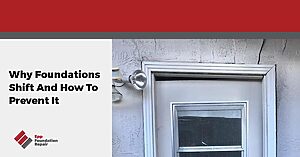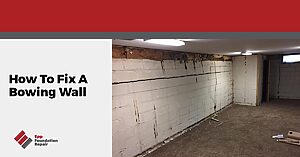Are you searching for “how to keep water away from house foundation”? If so, don’t hit that back button because this article is what you need to get started.
Your home’s structural integrity is only as good as the foundation it sits on. Therefore, a strong, solid foundation is a must if you want to avoid structural damage that could cost thousands of dollars to fix.
In this article, we’ll talk about not only how to keep water away from a house’s foundation but why as well. We’ll also give you some common signs of foundation trouble and briefly go over the most common repair methods. Hopefully, you will never need them.

Why you should keep water away from a foundation
Keeping water away from a house’s foundation is essential because – believe it or not – water is the most common cause of foundation trouble. For example, expansive clay soil expands when it soaks up water and then shrinks by that same amount when it dries out. This creates movement under the foundation. Expansive clay soil can also press against your foundation walls if hydrostatic pressure is allowed to build up in the soil. (Hydrostatic pressure builds when there’s excess water in the soil that can’t drain off.) This can cause cracks and bowing. Other soil types are prone to erosion, creating voids into which the house will settle. Both scenarios can lead to structural damage and costly repairs.
Of course, excess water in the soil around a foundation can also find its way into a basement or crawl space. While that might not be an immediate threat to your home’s structural integrity, it can be a nuisance that can cause damage and require repair.
Homeowners can avoid most foundation problems by simply getting groundwater under control. See The Importance Of Proper Foundation Drainage Around Your Home for more information.




How to keep water away from a house foundation
Because water is the leading cause of foundation trouble, homeowners should ensure good drainage around the foundation. You don’t want water pooling in the soil around the house. Here are some things you can do:
- Regrade your yard, if necessary – Your yard needs to slope away from your home. If it doesn’t, water will pool around the foundation and cause trouble.
- Install a drain tile system – A drail tile system is a gold standard for keeping water away from a house’s foundation. There are two types of drain tile systems, interior or exterior, and both work to keep water from building up in the soil around a foundation. For more information on how they work, see, How Does A Drain Tile System Work?
- Clean your gutters regularly – Clogged gutters can cause water to spill over the side of your home and into the soil around the foundation. Since you’re trying to keep water away from the foundation, you don’t want this to happen.
- Add downspout extensions, if necessary – If your downspouts are too short, they’ll release water next to the foundation. Downspout extensions are easy to install and carry the water away from the foundation before releasing it.
- Add an underground downspout leading to a bubbler pot – Downspouts can also be installed underground. The water goes into the underground downspout and then channeled away from the foundation and into something called a “bubbler pot.” Bubbler pots stay closed until a certain amount of head pressure (water pressure from the down spout) causes it to open and release the water.
- Don’t plant water-hungry shrubs and flowers near the foundation – When you water them, you’ll only be adding additional water to the soil around the foundation.
While you don’t want excess water in the soil around a foundation, you also don’t want to let the soil dry out and shrink because this can also lead to structural damage. Therefore, it’s essential to water the soil during the dry season to keep it moist.
You also don’t want to plant trees too close to your house because they can ‘’drink’’ up moisture, creating voids under the foundation.

Common signs of foundation trouble
Common signs of foundation trouble include:
- Windows and/or doors that are difficult to open and close – If the problem is limited to just one window or door, it’s probably not a sign of foundation trouble. However, multiple doors or windows with this problem should be checked out.
- Unlevel floors – You could check this by simply seeing what happens when you place something round on the floor. Does it roll in one direction? You could also use a beam level to check this.
- Ceilings and/or floors are no longer in contact with the wall – Even slight separations could indicate a foundation problem.
- Floor cracks – If the crack is limited to one or two tiles, it was probably created when something fell on the floor. However, a floor crack that runs wall to wall is a sign of foundation trouble.
- Wall cracks – Horizontal and diagonal cracks are a sign of foundation trouble. (Hairline, vertical wall cracks in a poured concrete foundation were probably caused by shrinkage during the concrete curing process.)
- Bowed walls – When there’s a build up of excess water in the soil outside a foundation wall, it can lead to bowing and even cracking due to hydrostatic pressure.
- Torn wallpaper – Check to see if the wall behind the wallpaper is cracked.
- Rotated walls – This happens when the outside of a foundation wall sinks into water-saturated soil, while the inside doesn’t because it’s on dry ground. This causes the wall to rotate.
- Diagonal cracks – Look for large diagonal cracks. (Hairline, diagonal cracks from the corners of windows and doors are probably nothing to worry about.)
- Moldings pulling away from the wall or ceiling – Again, even a slight separation could indicate a problem.
- Stair step cracks in brick or masonry – These are a clear sign of foundation trouble.
- Chimneys or porches pulling away from the house – Sometimes, this is a problem with the foundation under the chimney or porch. However, it could indicate a problem with your home’s foundation. So, it needs to be checked out.



Foundation repair methods
If your home’s foundation is already in trouble, don’t despair. The vast majority of foundation problems can be repaired. Here are a few of the most common foundation repair methods in use today:
- Push piers – Push piers are probably the most common foundation repair method. After they’re driven into the ground until they reach load-bearing soil, synchronized hydraulic jacks lift the structure back up.
- Helical piers – While helical piers are mainly used for new construction projects, they’re sometimes used for repair as well. They’re shaped like corkscrews and turned into the ground down to the load-bearing strata. Hydraulic jacks then lift the building.
- Wall plate anchors – Wall plate anchors are great for stabilizing walls that have bowed and/or cracked due to hydrostatic pressure.
- Carbon fiber straps – Carbon fiber is strong and can fix cracks in both poured concrete and block foundation walls.
- Epoxy injection – Some hairline cracks – usually vertical – in poured concrete foundation walls are caused by shrinkage during the concrete curing process. These can be repaired using epoxy injection. This will seal the cracks and stop moisture from making its way through the foundation wall.
For more information about foundation repair see Foundation Repair Methods And More
If you’re looking for advice on keeping water away from a house’s foundation and are in our service area in Lincoln, Omaha, Kearney, Nebraska, Missouri, Iowa, and parts of Northeastern Kansas, contact us today!







